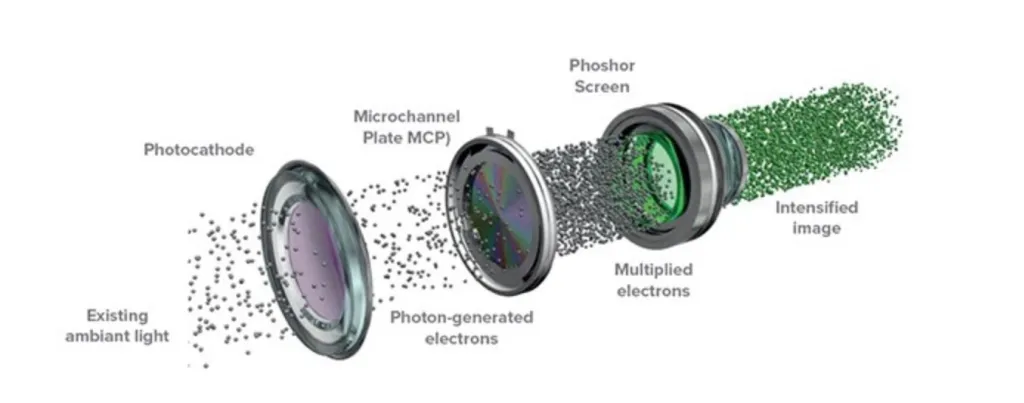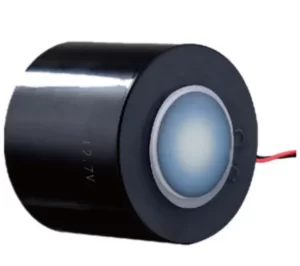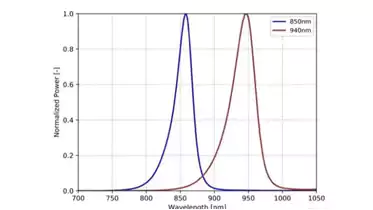What Is Night Vision
—Sichuan Binock Optoelectronic Technology Co., Ltd.—
A Night Vision Device (NVD) or Night Vision Goggles (NVG) is an optical instrument that enables visibility in low-light or completely dark environments. By amplifying faint light sources (such as moonlight or starlight) or utilizing infrared technology, it transforms invisible scenes into images perceptible to the human eye. Night vision devices are widely used in military operations, law enforcement, wildlife observation, nighttime navigation, and search-and-rescue missions.
How does night vision work?
The core technologies of night vision devices fall into three main categories: Image Intensification (covering Generations 1 to 4), Thermal Imaging, and Digital Night Vision. Below is a detailed explanation of each type’s working principle:


This diagram illustrates the working principle of a classic Generation 3 (Gen 3) image intensification night vision device, detailing how light signals are amplified and converted into a visible enhanced image through the device’s internal components. Below is a summary of the path shown in the diagram:
- Existing ambient light
- The night vision device first captures the faint available light in the environment (such as starlight or moonlight). This light enters the device’s initial optical system.
- Photocathode
- Incoming photons (light particles) strike the photocathode, generating electrons. This process converts the light signal into an electrical signal (Photon-generated electrons).
- Microchannel Plate (MCP)
- The photon-generated electrons are directed to the microchannel plate (MCP), a high-voltage electron multiplier. The MCP amplifies a single electron into a large number of electrons (Multiplied electrons) by multiple collisions within its channels, significantly boosting the signal.
- Phosphor Screen
- The multiplied electrons strike the phosphor screen, exciting the phosphor material to emit visible light (typically green). This creates the final enhanced image (Intensified image).
- Intensified image
- The green light emitted by the phosphor screen is presented to the user through an eyepiece or display, producing a bright night vision image that makes faint ambient light clearly visible.
The overall path is: ambient light → photocathode (light to electrons) → microchannel plate (electron multiplication) → phosphor screen (electrons to light) → intensified image. This diagram clearly demonstrates how night vision devices use electron multiplication technology to generate visible images in dark environments.
1. Image Intensification Technology
Image intensification night vision devices operate by collecting and amplifying weak ambient light (such as starlight or moonlight), making them suitable for low-light conditions. The central component is an Image Intensifier Tube, and the process works as follows:
- Photon Collection: The lens captures photons from the environment (including visible light and some near-infrared light).
- Photoelectric Conversion: Photons strike a photocathode, converting them into electrons. The photocathode material varies by generation (e.g., S-20 for Gen 1, gallium arsenide for Gen 3).
- Electron Amplification: Electrons enter a microchannel plate (MCP, present in Gen 2 and higher), where they are accelerated by an electric field and collide with the channel walls, triggering the release of additional electrons for signal amplification.
- Image Generation: The amplified electrons strike a phosphor screen, converting their energy into green or grayscale light dots, forming a visible image. Green is commonly used because the human eye is most sensitive to it, and phosphor screens typically use P22 or P43 materials.
- Generation 1 (Gen 1)
The most basic image intensification type, using only a photocathode and simple electron amplification without an MCP. It offers about 1000x amplification, with possible edge distortion, and requires an infrared illuminator in very dark conditions. Effective range is typically 50-100 meters. - Generation 2 (Gen 2)
Introduces an MCP, significantly boosting electron amplification (around 20,000x), resulting in clearer images with a resolution of 40-50 lp/mm (line pairs per millimeter). It performs better in lower light but still needs some ambient light. - Generation 3 (Gen 3)
Uses a gallium arsenide (GaAs) photocathode, more sensitive to infrared light, paired with an improved MCP, achieving up to 50,000x amplification and a resolution of 64 lp/mm or higher. Offers a longer lifespan (about 10,000 hours) and excels in extremely low light. - Generation 4 (Gen 4)
Employs gated filmless technology by removing the MCP’s ion barrier film, reducing electron scattering for lower noise and a wider dynamic range. Resolution can reach over 70 lp/mm, adapting to both bright and very dark conditions, though it’s rare in civilian markets due to high cost.
2. Thermal Imaging Technology
Thermal imaging night vision devices don’t rely on ambient light but detect infrared heat radiation (wavelengths of 8-14 microns) emitted by objects. All objects, even cold ones, emit heat based on temperature differences. The working principle is as follows:
- Heat Radiation Detection: Behind the lens is a microbolometer array (typically made of vanadium oxide or amorphous silicon), which senses infrared radiation and converts it into electrical signals.
- Signal Processing: The signals are amplified and digitized to create a thermal map. Temperature differences are represented in grayscale or pseudocolor (e.g., white-hot, black-hot, or rainbow modes).
- Image Display: The result is shown on a screen, with warmer objects typically appearing white or red and cooler ones black or blue.
- Features: Thermal imagers have lower resolution (commonly 320×240 or 640×480 pixels) but work in total darkness, smoke, or fog, with detection ranges from hundreds of meters to several kilometers (depending on lens and sensor quality).
3 . Digital Night Vision Technology
Digital night vision devices use modern electronic sensors to capture light and produce digital images, similar to the technology in digital cameras or smartphones. The working principle is as follows:
- Light Capture: The lens collects visible and near-infrared light (700-1000 nm), projecting it onto a sensor (e.g., CCD or CMOS). These sensors are sensitive to infrared, capturing wavelengths invisible to the human eye.
- Signal Conversion: The sensor converts photons into electrical signals, forming raw digital data. CMOS sensors are more common due to lower power consumption and cost, with resolutions ranging from 480p to 1080p.
- Digital Processing: A built-in Digital Signal Processor (DSP) amplifies the signal, reduces noise, and optimizes the image (e.g., adjusting contrast or sharpening edges). Users can select display modes like black-and-white, green, or color.
- Infrared Assistance: In no-light conditions, an integrated infrared illuminator (typically 850nm or 940nm LED) emits infrared light, which reflects back to the sensor to form an image. The 940nm wavelength is stealthier but slightly dimmer.
- Image Output: The processed image is displayed on an LCD or OLED screen, supporting real-time preview and recording as video or photos.
Types of Night Vision Devices
Based on technology generation and application, night vision devices are categorized as follows:
- Generation 1 (Gen 1): Basic image intensification, low cost, requires IR assistance.
- Generation 2 (Gen 2): With MCP, clearer images.
- Generation 3 (Gen 3): Gallium arsenide, military-grade.
- Generation 4 (Gen 4): Filmless tech, top performance.
- Digital Night Vision: Digital sensors, multifunctional and affordable.
- Thermal Imaging: Heat detection, works in total darkness.
Features and Advantages of Digital Night Vision
Digital night vision has gained attention in recent years due to its unique advantages:
- Versatility: Many devices support image and video recording, with options for Wi-Fi transmission to phones or computers and built-in memory card slots. For example, the BINOCK NVG30 offers 2K (2560×1440) video recording and real-time Wi-Fi streaming, with a 40Hz lag-free motion mode; the BINOCK NVG50 adds app-based remote control for enhanced recording and sharing.
- Durability: Based on electronic sensors, they’re less sensitive to bright light and usable day or night. Both NVG30and NVG50 feature IPX7 waterproofing, making them resilient in harsh outdoor conditions.
- Cost-Effectiveness: Lower production costs compared to Gen 2 or Gen 3 devices make them more affordable. The NVG30 delivers high value under $500, while the NVG50, launched in 2024, offers a lighter design (192g) for even better cost efficiency.
- Display Quality: Electronic screens allow brightness and resolution adjustments, with multiple color modes (e.g., black-and-white, green, white phosphor). The NVG30 boasts a 40° field of view (FOV) and an OLED display for near-natural viewing; the NVG50 upgrades to a 45° FOV and 1440p screen for wider, sharper visuals.
- Technical Advantages: Digital signal processing enables integration with modern features like GPS, timestamps, and auto-brightness. The NVG30 includes smart IR intensity adjustment for varying light conditions; the NVG50adds a flip-up screen and reticle assist, compatible with rifle scopes, boosting night vision performance by about 30%.
- Portability and Compatibility: The NVG30 supports helmet mounting and binocular setups, with a 940nm stealth IR illuminator and a 600-meter range; the NVG50, at 87x65x20mm, is compact, supports internal or external batteries, and fits Picatinny rails for tactical use.
Applications of Night Vision Devices
Military and Law Enforcement: Nighttime operations, surveillance; digital types for recording.
Civilian Use: Hunting, camping; digital models for photography.
Entertainment and Technology: Night exploration, creative imaging.
ADVANTAGES AND DISADVANTAGES
Advantages:
- Extends visibility in darkness.
- Diverse technologies, highly adaptable.
- Digital models offer rich features at lower costs.
Disadvantages:
- High-end models are expensive.
- Image intensification needs some light.
- Digital types may lag in long-range performance.
CONCLUSION
Night vision devices have transcended the limits of natural light, evolving from image intensification to thermal imaging and digital technology. Devices like the BINOCK NVG30 and NVG50, with their advanced features and affordability, are bringing digital night vision into everyday life. As performance improves and costs decrease, night vision technology is poised to become even more widespread.







